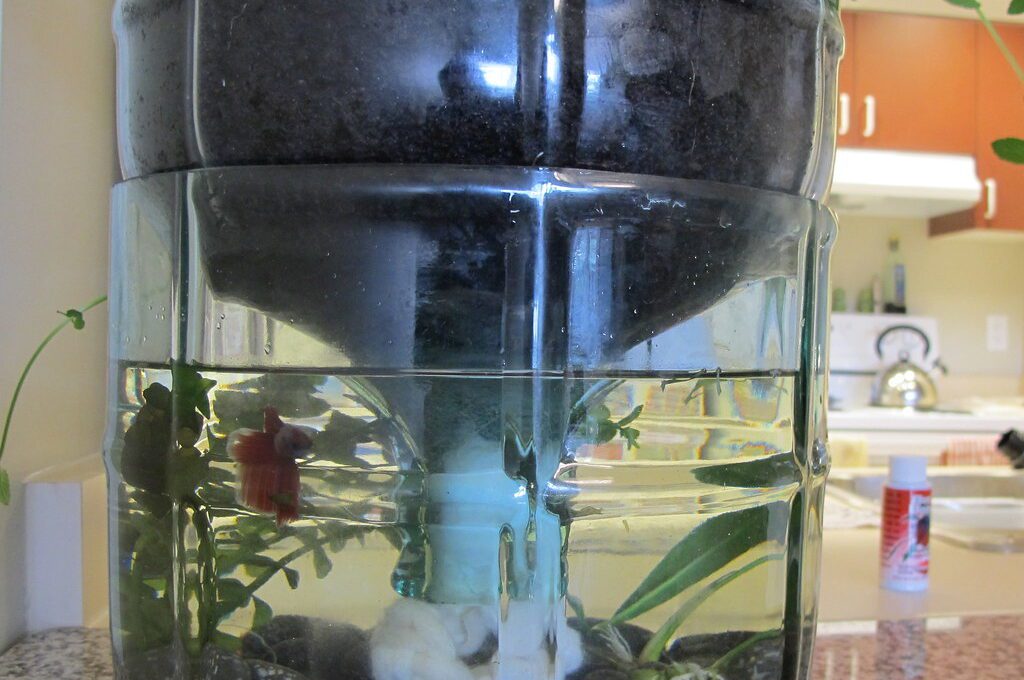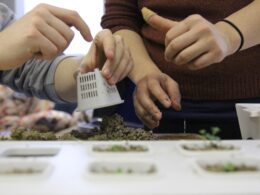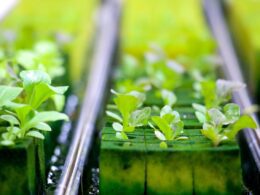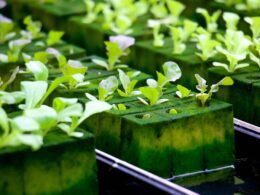Do you worry about your hydroponic plants developing root rot? Root rot is a common problem in hydroponics, and it can be devastating for your plants if not addressed promptly. In this article, we will discuss the causes of root rot in hydroponics, how to identify it, and what you can do to prevent and treat it.
Hydroponics is a great way to grow plants without soil, but it requires a careful balance of water, nutrients, and oxygen. If any of these factors are out of balance, your plants may be at risk of developing root rot.
Root rot is a fungal disease that attacks the roots of your plants, leading to stunted growth, yellowing leaves, and even death. Don’t let root rot ruin your hydroponic garden – read on to learn how to prevent and treat it.
Causes of Root Rot in Hydroponics
The main culprits behind this pesky problem in hydroponics are excess moisture and lack of oxygen. These conditions create the perfect environment for common root rot pathogens to thrive. These pathogens attack the roots of your plants and can quickly spread throughout your entire hydroponic system.
To avoid root rot in hydroponics, it’s important to choose the best plants for your setup. Some plants are more susceptible to root rot than others, so it’s important to do your research and choose plants that are known for their resilience. For example, lettuce, herbs, and tomatoes are great options for hydroponic systems because they have a lower risk of developing root rot.
In addition to selecting the right plants, it’s important to maintain a balance of moisture and oxygen in your hydroponic system. This can be achieved by using a high-quality growing medium and monitoring the water level regularly.
By taking proactive measures to prevent root rot, you can ensure that your hydroponic garden thrives and produces healthy, vibrant plants.
Signs of Root Rot
You might notice some indications of your plants struggling, such as soft and discolored roots, foul odor, and wilting leaves, indicating a potential case of root rot. Root rot is a common problem in hydroponics, but it’s often misunderstood.
Common misconceptions include the belief that hydroponics eliminates the risk of root rot and that it only occurs in soil-based systems. However, root rot can also occur in hydroponic setups, and it can have a significant impact on plant growth.
Here are five signs of root rot that you should look out for in your hydroponic system:
- Soft, slimy roots that are brown or black in color
- A foul odor coming from the roots or water reservoir
- Wilting leaves or stunted growth
- Poor nutrient uptake, leading to nutrient deficiencies
- Algae growth in the water reservoir
If you notice any of these signs in your hydroponic system, it’s important to take action immediately to prevent the spread of root rot. Root rot can have a significant impact on plant growth, as it can reduce the plant’s ability to absorb water and nutrients. This can lead to stunted growth, poor yields, and even the death of your plants.
Remember, prevention is key when it comes to root rot in hydroponics. By maintaining proper pH levels, avoiding overwatering, and regularly cleaning and disinfecting your hydroponic setup, you can reduce the risk of root rot and ensure healthy, thriving plants.
What Factors Prevent Roots from Rotting in Hydroponics?
Proper oxygenation and the absence of water logging are crucial factors to prevent roots rot in hydroponics. These systems usually incorporate techniques like aeroponics or deep water culture to ensure that the roots receive sufficient oxygen. Additionally, maintaining a balanced nutrient solution and avoiding over-watering are essential to reduce the risk of root rot and promote healthy growth in hydroponics.
Prevention Measures
Preventing the spread of root rot in your hydroponic system is crucial for the health and longevity of your plants. One of the most important measures you can take is to maintain your hydroponic system properly.
Regular cleaning of your system, removal of dead plant material, and proper disposal of contaminated water are all necessary steps. It’s also important to monitor your nutrient solution and make sure it’s properly balanced.
Another factor to consider is pH control. Maintaining the proper pH range for your plants is essential in preventing the growth of root rot. A pH that’s too high or too low can lead to the growth of harmful bacteria and fungi. Therefore, it’s important to regularly check and adjust the pH levels of your nutrient solution.
In addition to hydroponic system maintenance and pH control, there are other measures you can take to prevent root rot. For example, it’s important to use high-quality seeds and plants, as well as sterilized growing media. You can also use beneficial bacteria and fungi to help prevent harmful growth.
By taking these measures, you can help ensure the health and longevity of your plants in your hydroponic system.
Treatment of Root Rot
If you notice root rot in your hydroponic system, there are several treatment options available to you.
First, you should remove any affected plant parts to prevent further spread of the infection.
Then, you can use hydrogen peroxide to sanitize your system and kill any remaining pathogens.
Finally, adjusting nutrient levels can help promote the growth of healthy roots and prevent future occurrences of root rot.
Removal of Affected Plant Parts
Proactively removing any damaged or infected parts of the plant can aid in maintaining healthy growth in a hydroponic system. When you notice any signs of root rot, such as wilted leaves or discolored roots, it’s important to act quickly.
Cut away the affected plant parts using clean tools and dispose of them properly to prevent further spread of the disease. Removing affected plants can help reduce the amount of harmful microorganisms in the system, which can also prevent the spread of root rot.
Be sure to sanitize your tools and any surfaces that came into contact with the infected plant parts to avoid spreading the disease to other plants. Regularly inspecting your plants and taking proactive measures like this can help you maintain a healthy and thriving hydroponic system.
Use of Hydrogen Peroxide
Now that you’ve learned about the importance of removing affected plant parts in preventing root rot, let’s talk about another effective method to combat this issue: hydrogen peroxide.
Hydrogen peroxide is a commonly used treatment in hydroponics because of its effectiveness in killing harmful bacteria and fungi. It works by releasing oxygen, which helps to aerate the roots and prevent further damage.
However, it’s important to note that hydrogen peroxide can be harmful if not used properly. Safety precautions such as wearing gloves and eye protection should be taken when handling it. Additionally, it’s important to follow dosage recommendations carefully, as using too much can harm the plants.
There are also alternative treatments available, such as beneficial bacteria solutions, that can be used in conjunction with hydrogen peroxide for added protection.
By utilizing these methods, you can help prevent root rot and keep your hydroponic garden healthy and thriving.
Adjusting Nutrient Levels
Adjusting nutrient levels is crucial for maintaining the health of your hydroponic plants and ensuring optimal growth.
pH management is a crucial aspect of nutrient level adjustment. The pH level of the nutrient solution affects the availability of nutrients to the plants. If the pH level is too high or too low, the plants may experience nutrient deficiency, which can lead to stunted growth, yellowing leaves, and other health problems.
To ensure that your plants receive the proper nutrients, you should regularly test the pH level of the nutrient solution and adjust it if necessary.
Another important aspect of adjusting nutrient levels is monitoring for nutrient deficiency. Nutrient deficiency can occur when the plants do not receive enough of a particular nutrient, such as nitrogen, phosphorus, or potassium.
Symptoms of nutrient deficiency include yellowing leaves, stunted growth, and poor fruit or flower development. To prevent nutrient deficiency, you should regularly check the nutrient levels of your hydroponic solution and make adjustments as needed.
By staying on top of pH management and nutrient deficiency, you can ensure that your hydroponic plants grow healthy and strong, without the risk of root rot.
Conclusion and Future Prevention Measures
By implementing these prevention measures, you can ensure the longevity and success of your hydroponic system.
The first and most important prevention method is to maintain proper ventilation. Roots need oxygen to thrive, and too much water or moisture can result in a lack of oxygen. Make sure your hydroponic system has adequate ventilation and airflow to prevent root rot.
Another prevention method is to monitor nutrient levels regularly. Overfeeding your plants can lead to a buildup of nutrients and salts, which can harm the roots and encourage the growth of harmful bacteria and fungus. Be sure to follow the recommended nutrient levels for your particular plant and adjust as needed based on the age and growth stage of your plants.
In addition to these prevention methods, it’s important to consider future implications when designing and maintaining your hydroponic system. Make sure your system is easy to clean and maintain, and consider using organic or natural methods to control pests and diseases.
By taking a proactive approach and implementing these prevention measures, you can ensure the long-term success of your hydroponic system and enjoy healthy, thriving plants for years to come.
Frequently Asked Questions
Can I save plants that are already affected by root rot?
If you’ve noticed your hydroponic plants becoming affected by root rot, don’t panic. There are steps you can take to save your plants and prevent further damage.
First, remove any affected roots with clean scissors or shears.
Next, make sure you’re providing proper plant care by maintaining a clean and sterile environment, ensuring adequate oxygenation, and avoiding overfeeding or overwatering. You may also want to consider adding beneficial bacteria or fungi to your hydroponic system to promote healthy root growth.
Remember, prevention is key, so be sure to practice proper plant care to avoid root rot in the future.
Can I reuse the nutrient solution after treating root rot?
If you’ve treated root rot in your hydroponic system and are wondering if you can reuse the nutrient solution, the answer is yes, but with caution. Before reusing the solution, make sure to treat it with a disinfectant and monitor it closely for any signs of contamination.
It’s important to prevent any potential contamination from spreading and causing further issues in your plants. With proper treatment and monitoring, you can safely reuse the nutrient solution in your hydroponic system.
How often should I change the nutrient solution to prevent root rot?
To prevent root rot in your hydroponic system, it’s crucial to change the nutrient solution regularly. Aim to change it every two to three weeks, depending on the type of plant you’re growing and how quickly it consumes the nutrients.
Look out for signs of root rot, such as yellowing or wilting leaves, foul smell, or slimy roots. If you notice these symptoms, take preventive measures immediately, such as reducing the amount of water or adding an antifungal treatment.
Regular maintenance and vigilance are key to keeping your plants healthy and thriving in a hydroponic system.
Can I prevent root rot by using certain types of hydroponic systems?
When it comes to preventing root rot, choosing the right hydroponic system can make all the difference. There are various types of hydroponic systems for root health, but aeroponic systems are particularly effective at preventing root rot.
In these systems, the roots are suspended in the air and misted with a nutrient solution, providing them with ample oxygen and preventing water from pooling around the roots. This type of system not only prevents root rot but also allows for faster growth and higher yields.
So, if you want to ensure the health of your hydroponic plants, consider investing in an aeroponic system.
Are there any natural remedies for preventing or treating root rot in hydroponics?
To prevent or treat root rot in hydroponics, essential oils can be used as a natural remedy. Tea tree, oregano, and cinnamon essential oils have anti-fungal properties that can help prevent harmful bacteria growth in hydroponic systems.
Additionally, maintaining proper pH levels in your hydroponic system can play a role in preventing root rot. For most plants, a pH level between 5.5 and 6.5 is ideal. By regularly testing and adjusting pH levels, you can create an environment less conducive to harmful bacteria and fungi growth.
Incorporating these natural remedies into your hydroponic gardening routine can help ensure healthy and successful plant growth.
Conclusion
So, now you know that root rot can occur in hydroponics, but with proper prevention measures, you can avoid it.
Keep your water and nutrient solution clean, monitor pH and EC levels, and provide adequate aeration and circulation.
If you do notice signs of root rot, such as brown or slimy roots, act quickly and remove any affected plants.
Treat the remaining plants with a hydrogen peroxide solution, and consider adding beneficial bacteria to your system to help prevent future outbreaks.
Overall, hydroponics is a great way to grow plants, but it does require some maintenance to avoid issues like root rot.
With proper care and attention, you can enjoy a healthy and thriving hydroponic garden.
So, get growing and happy gardening!









